MARIANI’S
Virtual
Gourmet
December
17, 2017
NEWSLETTER
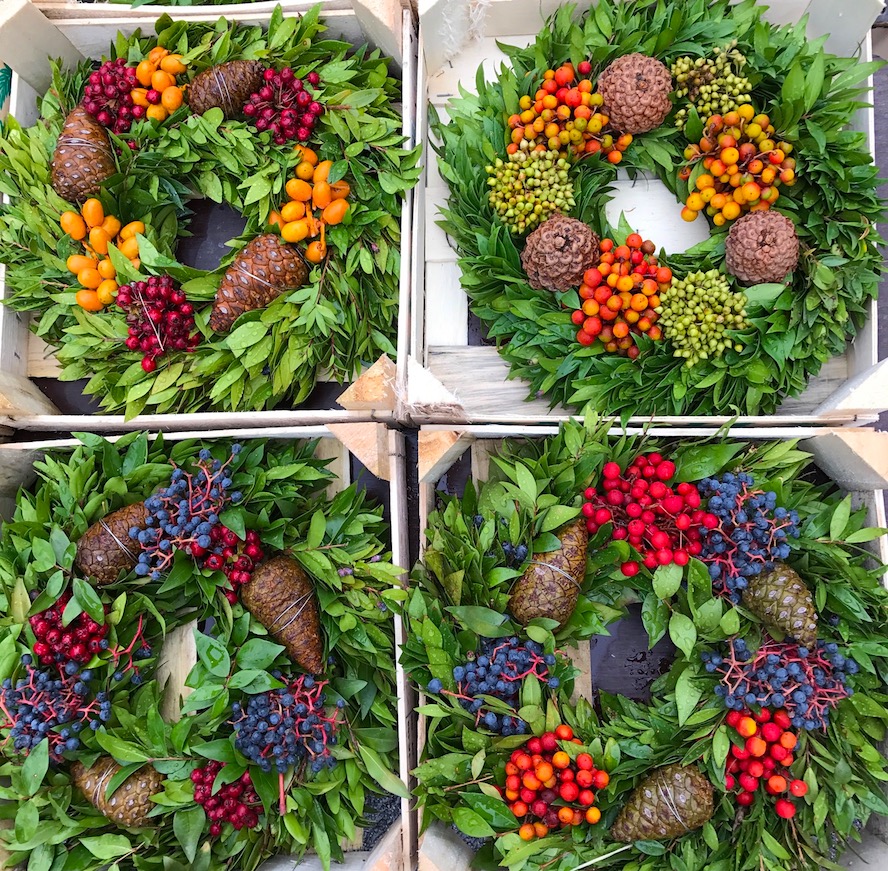
Photo by Galina Dargery
❖❖❖
IN THIS ISSUE
GREAT RESTORATIONS, PART TWO PARIS
PARIS DINING RIGHT NOW
By John Mariani
NEW YORK CORNER
NIRVANA
By John Mariani
MORE AND MORE ITALIAN COOKBOOKS
By John Mariani
NOTES FROM THE WINE CELLAR
WHAT I'M DRINKING FOR CHRISTMAS
BY JOHN MARIANI
❖❖❖
 A GREAT
CHRISTMAS GIFT!
A GREAT
CHRISTMAS GIFT!The Hound in Heaven (21st Century Lion Books) by John Mariani is a novella, and for anyone who loves dogs, Christmas, romance, inspiration, even the supernatural, I hope you'll find this to be a treasured favorite. The story concerns how, after a New England teacher, his wife and their two daughters adopt a stray puppy found in their barn in northern Maine, their lives seem full of promise. But when tragedy strikes, their wonderful dog Lazarus and the spirit of Christmas are the only things that may bring his master back from the edge of despair.
WATCH THE VIDEO!
❖❖❖
GREAT RESTORATIONS,
PART TWO PARIS
The Plaza-Athenée
By John Mariani
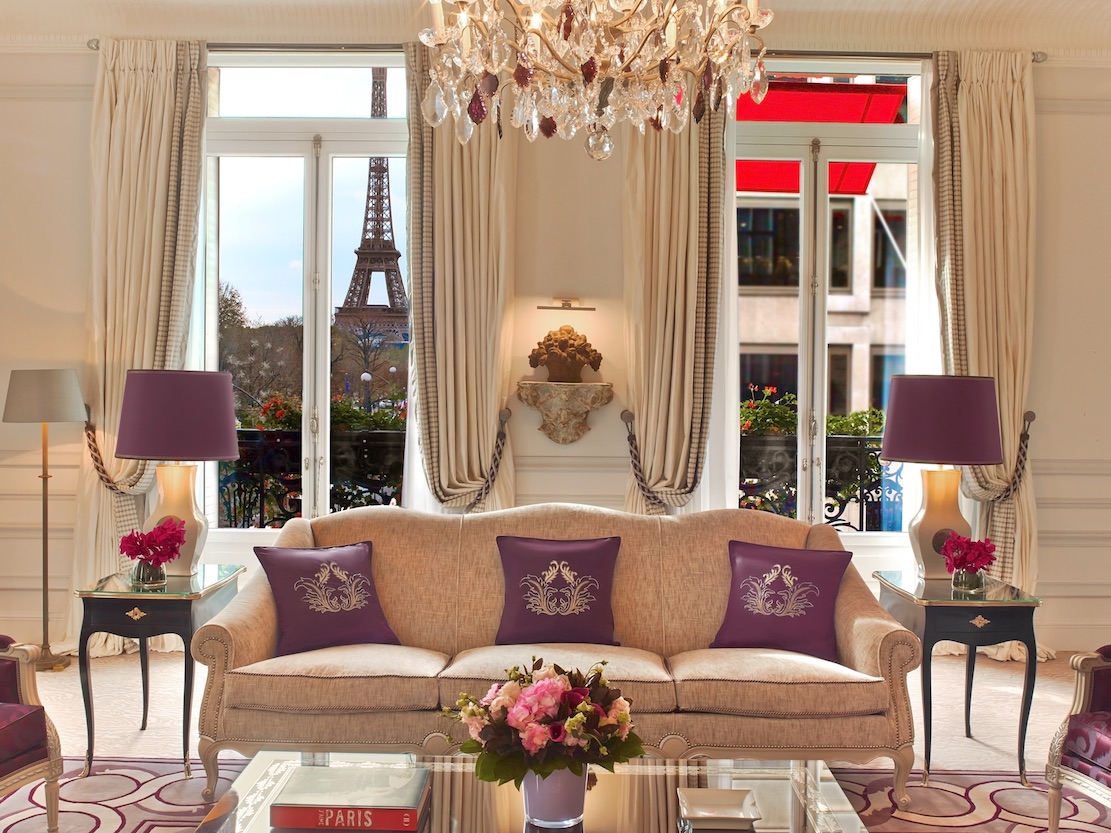
Little
that happens in Europe seems to affect
the super deluxe hotel market in Paris.
True, there was a downturn after the
economic crash of 2008 and the
terrorist attacks had a momentary impact, but
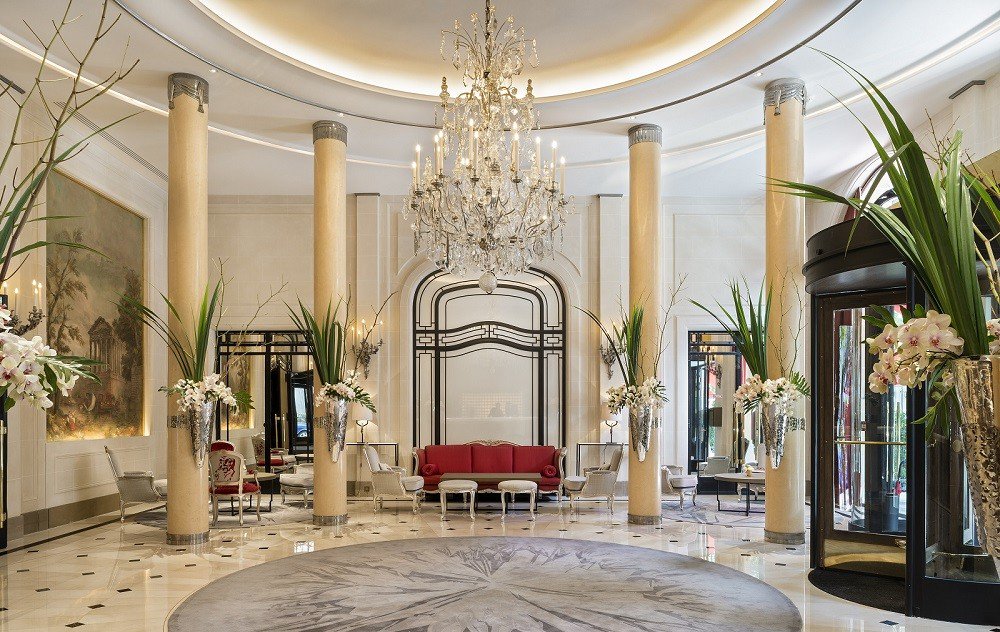 Paris
is nothing if not resilient
and Parisians are dedicated to the proposition
that life must be lived to the
hilt at hotels like The Plaza-Athenée.
Paris
is nothing if not resilient
and Parisians are dedicated to the proposition
that life must be lived to the
hilt at hotels like The Plaza-Athenée.
The hotel underwent a 200 million euro ($268 million) expansion and renovation, and the day it re-opened in 2014, every one of its 154 rooms and 54 suites were booked. By integrating with three buildings that surround the hotel, including two luxury townhouses, The Plaza-Athenée has added 14 sumptuous guest rooms and three event spaces. Outside, its famous bright red awnings are fresh and new, its geraniums in full bloom.
The
hotel debuted in 1913, managing to
stay open during the First World War and expanding
in size in the 1920s. In
2001 it was acquired three years
later by the Dorchester Collection, whose
properties include Le Meurice in
Paris, The Dorchester and 45 Park Lane in London,
Hotel Principe di Savoia in
Milan, Hotel Eden in Rome and the Beverly Hills
Hotel and the Hotel Bel–Air in
Los Angeles. Each is geared to its location, so
that the Plaza-Athenée, set
squarely on the Avenue de Montaigne, made sure
during the restoration that
dozens of rooms and suites have dramatic views of
the Eiffel 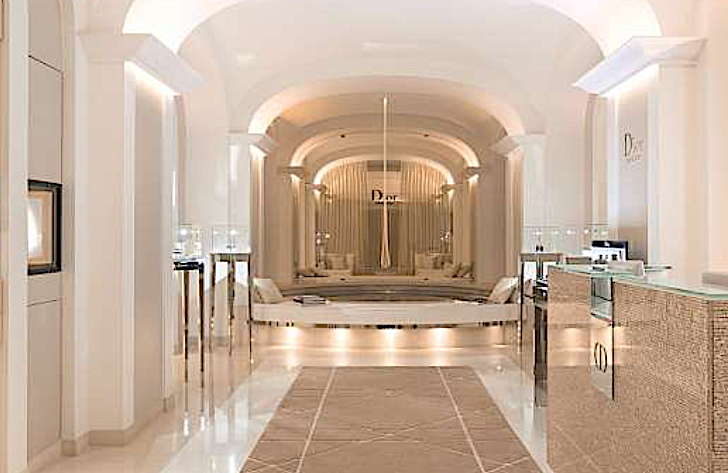 Tower. And
every night throughout the year,
the Tower lights up and sparkles for ten minutes
at a time. What better vantage
point than a terrace at the Plaza-Athenée?
Tower. And
every night throughout the year,
the Tower lights up and sparkles for ten minutes
at a time. What better vantage
point than a terrace at the Plaza-Athenée?
As at all the grand palais hotels of Paris—the Crillon, Ritz, Le Bristol, and others—restoration and enlargement were needed at Plaza-Athenée, not just to bring back what had been a regular, if aging, clientele but also to attract a younger generation for whom light, color and every modern amenity for the business traveler would be available. (I recall that some years ago most of the deluxe hotels actually charged for Wi-fi, which struck many as the height of penny pinching; today Wi-fi is free.)
There is new white Carrara marble in the grand
lobby (above)
of the Plaza-Athenée, and heavy curtains have been
removed in order to
let in the natural light. The place is awash with
huge displays of flowers,
while roses of every color are everywhere. In
2008, the Dior Beauty Institut was opened at the
hotel (left).
Alain Ducasse’s
namesake restaurant 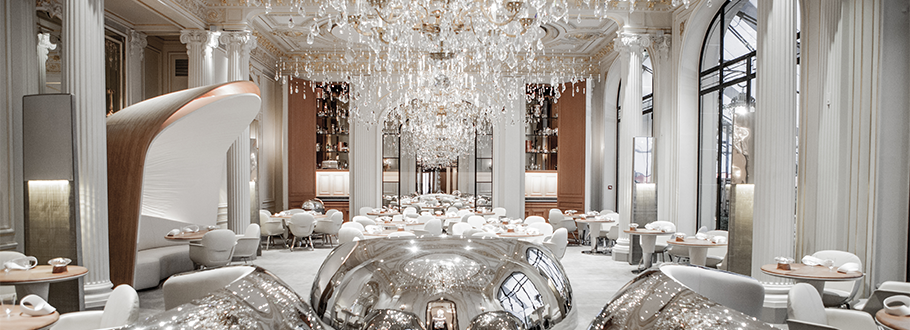 (three
Michelin stars), which was once quite staid back
in 2001, now shimmers with
pale gray and white colors, curved mirrored
installations, sparkling crystal
snowfall chandeliers and dramatic dining alcoves,
while the tables are now polished
wood, all punctuated by works of art by Pierre
Tachon, Shinichiro Ogata, Rina
Menardi, Gérard Crociani and Tina Frey (right).
(three
Michelin stars), which was once quite staid back
in 2001, now shimmers with
pale gray and white colors, curved mirrored
installations, sparkling crystal
snowfall chandeliers and dramatic dining alcoves,
while the tables are now polished
wood, all punctuated by works of art by Pierre
Tachon, Shinichiro Ogata, Rina
Menardi, Gérard Crociani and Tina Frey (right).
I did not have a chance to dine at Alain
Ducasse this time around, but he has taken a sharp
new direction with his
menus, inspired by what he calls “the
fish-vegetables-cereals trilogy,” with
chef Romain Meder. The natural flavors of
unusual ingredients are the menu’s focus in
dishes like hemp
seeds,
leaves and butternut squash and pumpkin (95€);
green lentils and
caviar, with flavored jelly (190€) and sea
scallops,
cauliflower and Comté cheese in pastry crust,
with white
Alba
truffles
(195€). There
is also a “Menu
Garden-Marine” of three-half dishes and dessert at
390€.
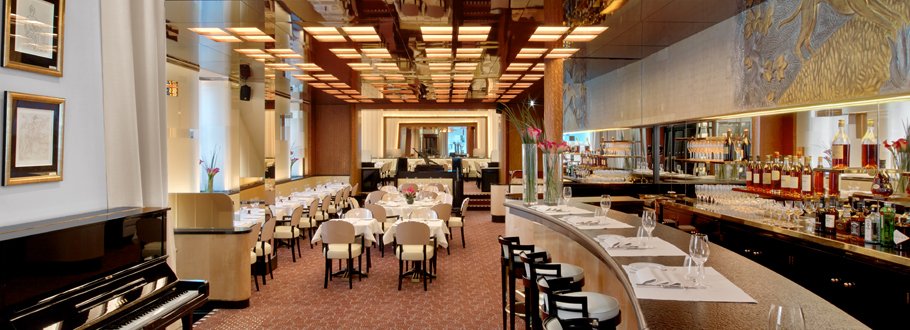 Head
sommelier Gérard
Margeon classifies his wines by generation, ten
years, 15 years and back to 55
years, rather than region.
Head
sommelier Gérard
Margeon classifies his wines by generation, ten
years, 15 years and back to 55
years, rather than region.
Because the hotel’s more casual, and less expensive, Le Relais restaurant (left) is a historic landmark—opened in 1936 and used as a cafeteria for American soldiers after the Liberation of Paris—the room still looks much the same, but everything about its original art déco posh has been brightened and better lighted. Chef Philippe Marc features contemporary bistro cuisine. (Ducasse runs both restaurants.)
At Le Relais my
wife and I enjoyed a dinner
that began with excellent duck foie gras mi-cuit
with figs (34€) and risotto with black truffles
(72€), then moved on to a succulent roast chicken
from Landes carved tableside (48€) and crispy pork
belly with creamy polenta and 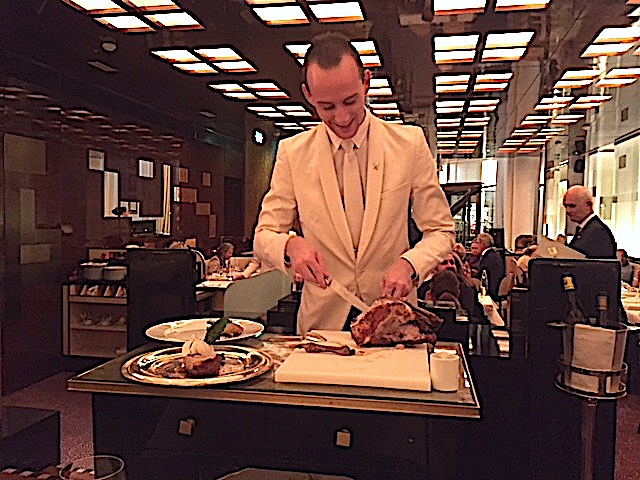 olives
(34€), ending off
with a superb baba soaked
in aged
rum (20€) and a pecan-studded,
cream-filled Paris-Brest (20€) by pastry chef
Angelo Musa.
There is also a very well-priced
three-course for both lunch and dinner at 54€.
olives
(34€), ending off
with a superb baba soaked
in aged
rum (20€) and a pecan-studded,
cream-filled Paris-Brest (20€) by pastry chef
Angelo Musa.
There is also a very well-priced
three-course for both lunch and dinner at 54€.
La Galerie is yet another venue, this one for breakfast, a light lunch, afternoon tea and from now until December 31, a repast of pastries, sandwiches and cakes along with the hotel’s special hot chocolate for 48€.
Most glamorous of all is the new Le Bar, with its violet blue ceiling clouds of fabric, transparent resin bar, an array of signature cocktails, and a menu of club sandwiches and sushi, all accompanied by live jazz.
My wife and I, just off a ten-day trip through
Brittany and Normandy, sank deeply into our beds
in a Junior Suite, which had
one of the longest 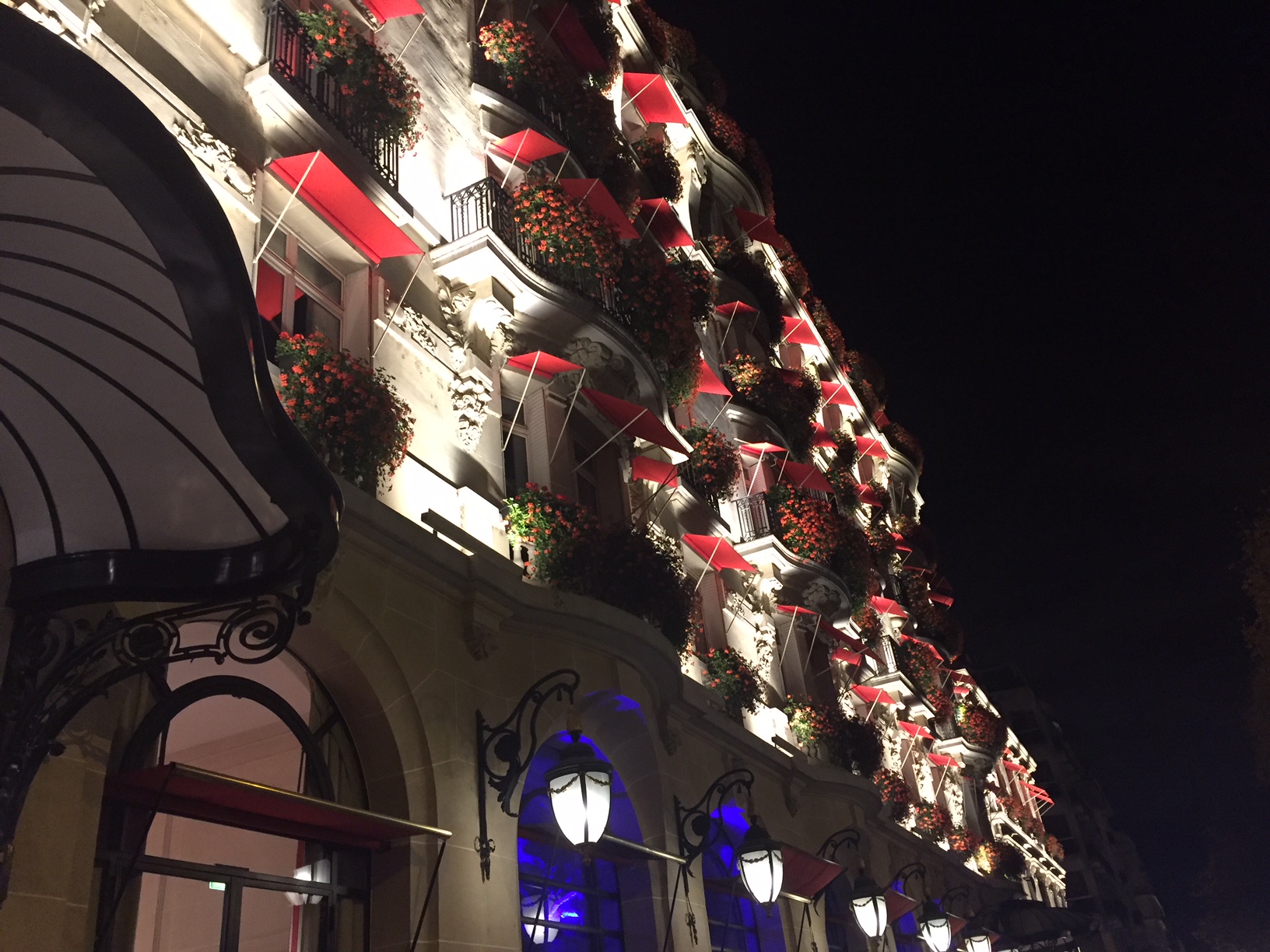 marbled bathrooms I’ve
seen in Paris.
The colors of taupe and shades of
violet, the delicate furniture, the vase of pink
roses, and the view of the
Eiffel Tower all contributed to a sense of 21st
century elegance such hotels
never had back when what was old was venerated and
what was new was
suspect. Yet,
no one would ever
mistake the Plaza-Athenée for any other hotel, not
even in Paris.
marbled bathrooms I’ve
seen in Paris.
The colors of taupe and shades of
violet, the delicate furniture, the vase of pink
roses, and the view of the
Eiffel Tower all contributed to a sense of 21st
century elegance such hotels
never had back when what was old was venerated and
what was new was
suspect. Yet,
no one would ever
mistake the Plaza-Athenée for any other hotel, not
even in Paris.
Those
lipstick-colored awnings stay
with you and bring back memories, and that view of
the Eiffel Tower at night is
something you never forget.
❖❖❖
By John Mariani
NIRVANA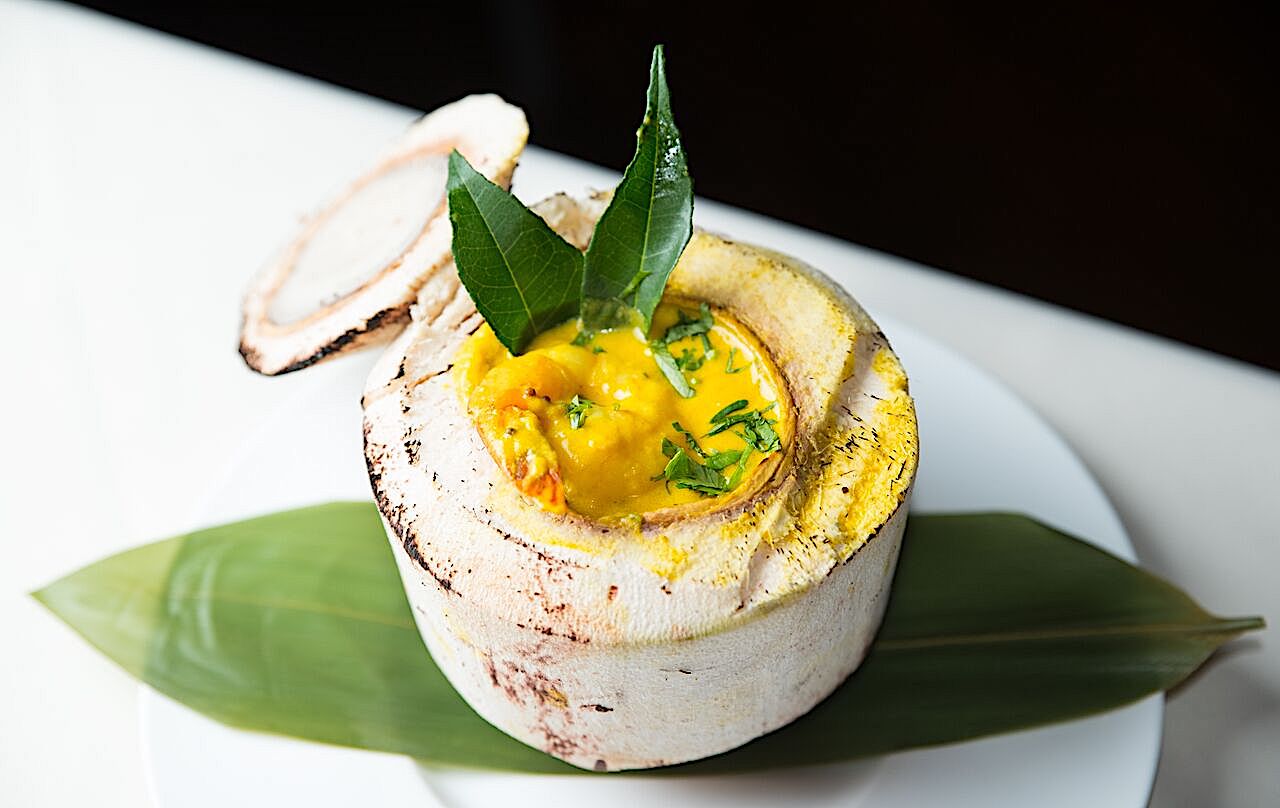
346 Lexington Avenue (near 40th Street)
212-983-0000
Nirvana is a handsome, two-story, skylighted, brick-walled restaurant, now ten years old, that lies just outside of what is called Manhattan’s Curry Hill, the streets in the 20s that flank Lexington Avenue and are filled with Indian restaurants and food markets. Like Nirvana’s location, owner Anin Amin is joining a trend to get away from the Mughal menus that once blanketed Indian restaurants from New York to London. That cuisine was rich, its sauces heavy, and the influence of the British Raj was rife in dishes like mulligatawny soup and various curries.
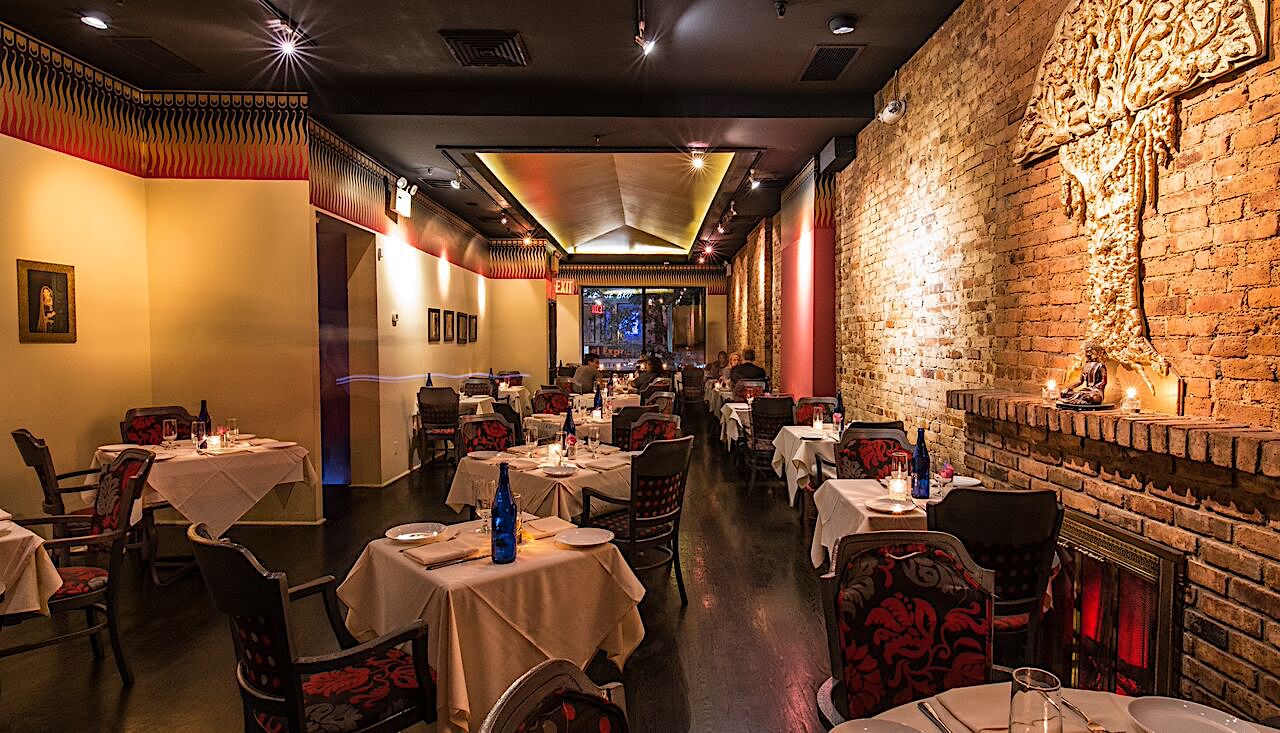 Downstairs
at Nirvana is a sleek 14-seat bar
and more intimate lounge done in vermillion
colors; upstairs is the dining
room, where vermilion is also accented along
with well-lighted Indian artwork
that includes a bas-relief bodhi tree
beneath
which sits a serene Buddha statuette. Tables are
nicely set with double
cloths. The lighting throughout is seductively
soothing, and the noise level in
the restaurant is quite civilized.
Downstairs
at Nirvana is a sleek 14-seat bar
and more intimate lounge done in vermillion
colors; upstairs is the dining
room, where vermilion is also accented along
with well-lighted Indian artwork
that includes a bas-relief bodhi tree
beneath
which sits a serene Buddha statuette. Tables are
nicely set with double
cloths. The lighting throughout is seductively
soothing, and the noise level in
the restaurant is quite civilized.
Chef Peter Beck has a high profile among NYC chefs, having won praise for his cooking at Chola and Tamarind, and at Nirvana. He is now showcasing more Southern Indian cooking and vegetable dishes.
You
can still find mulligatawny and other Mughal
dishes at Nirvana, but they are of
less interest than the regional fare Beck
serves, like a starter of brijwasi
tikki ($9; above)  made
with “hung
yogurt” that concentrates its taste and texture,
blended with ginger and
cumin. Chicken
65 ($10) is a hotly
spiced South Indian stir fry (right) ,
and I’ve never before eaten calamari bhajia, coated
in a spiced batter, fried
and served with crisp fritters ($12). Tamer by
far was tawa machi, a semolina-crusted
whole sea bass ($14); and achari mushrooms
in pickled seasonings
grilled in the tandoor ($11) made for a nice, if
bland, bite at the beginning
of the meal.
Seared tiger shrimp tadka
($14) came to the table not
entirely cooked through, so it was whisked away
and made right within minutes.
made
with “hung
yogurt” that concentrates its taste and texture,
blended with ginger and
cumin. Chicken
65 ($10) is a hotly
spiced South Indian stir fry (right) ,
and I’ve never before eaten calamari bhajia, coated
in a spiced batter, fried
and served with crisp fritters ($12). Tamer by
far was tawa machi, a semolina-crusted
whole sea bass ($14); and achari mushrooms
in pickled seasonings
grilled in the tandoor ($11) made for a nice, if
bland, bite at the beginning
of the meal.
Seared tiger shrimp tadka
($14) came to the table not
entirely cooked through, so it was whisked away
and made right within minutes.
Not to be missed is
patli ranee ($26), a massive
spice-rubbed lamb shank braised in a masala
broth that makes the meat fall
from the bone; it served four of us handily. Then there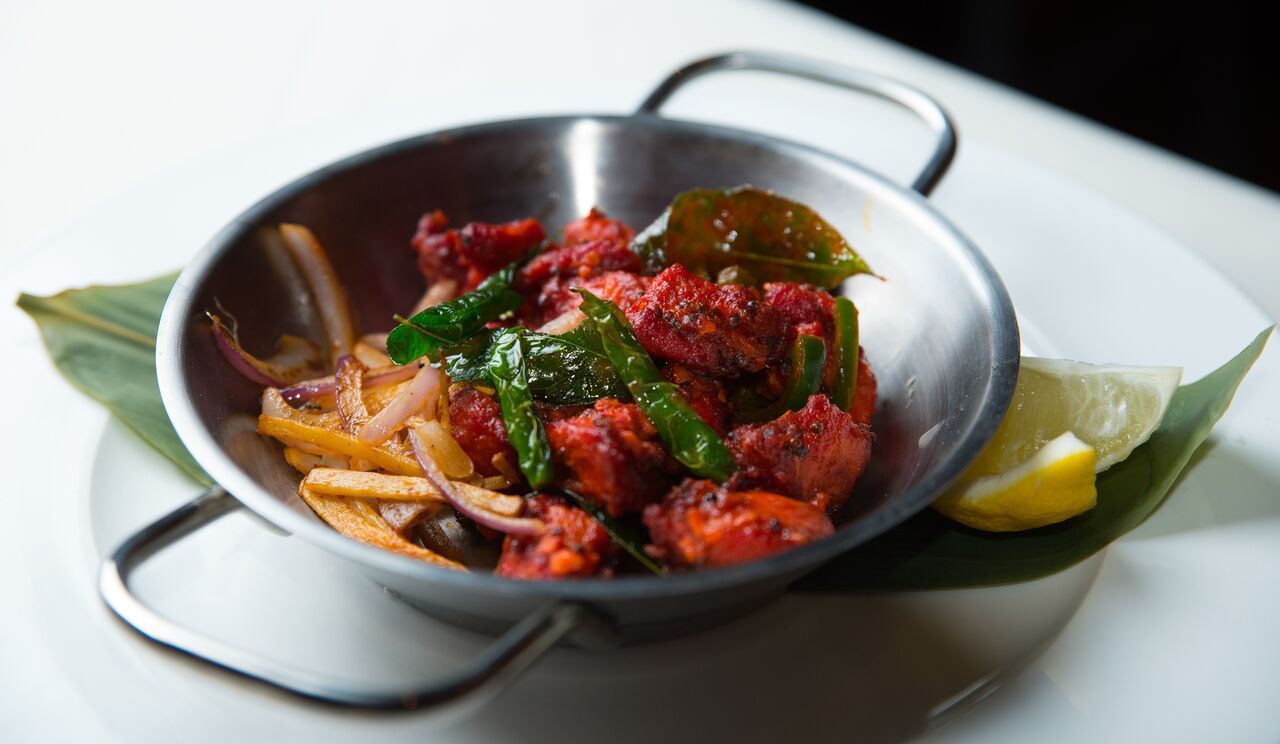 was the
Bengali dish dab chingri, shrimp with assertive
mustard, curry spices, coconut
water and milk ($24).
was the
Bengali dish dab chingri, shrimp with assertive
mustard, curry spices, coconut
water and milk ($24).
Beck has always featured a large number of vegetable dishes, and I recommend his aloo rabi mytter bangali suzi ($17), quite a mouthful figuratively and literally, composed of potatoes, cauliflower, peas, cumin, onion and seed spices ($17). Saag paneer is a very traditional dish of Indian cheese in garlic, ginger and herbs with spinach ($17). I only had a chance to try one bread, garlic naan ($6), which was all right, but I wish I’d had tasted a wider variety.
Desserts are no more unusual than you’d find elsewhere, but they are freshly made.
Open for lunch and dinner daily.
❖❖❖
ITALIAN COOKBOOKS
By John Mariani
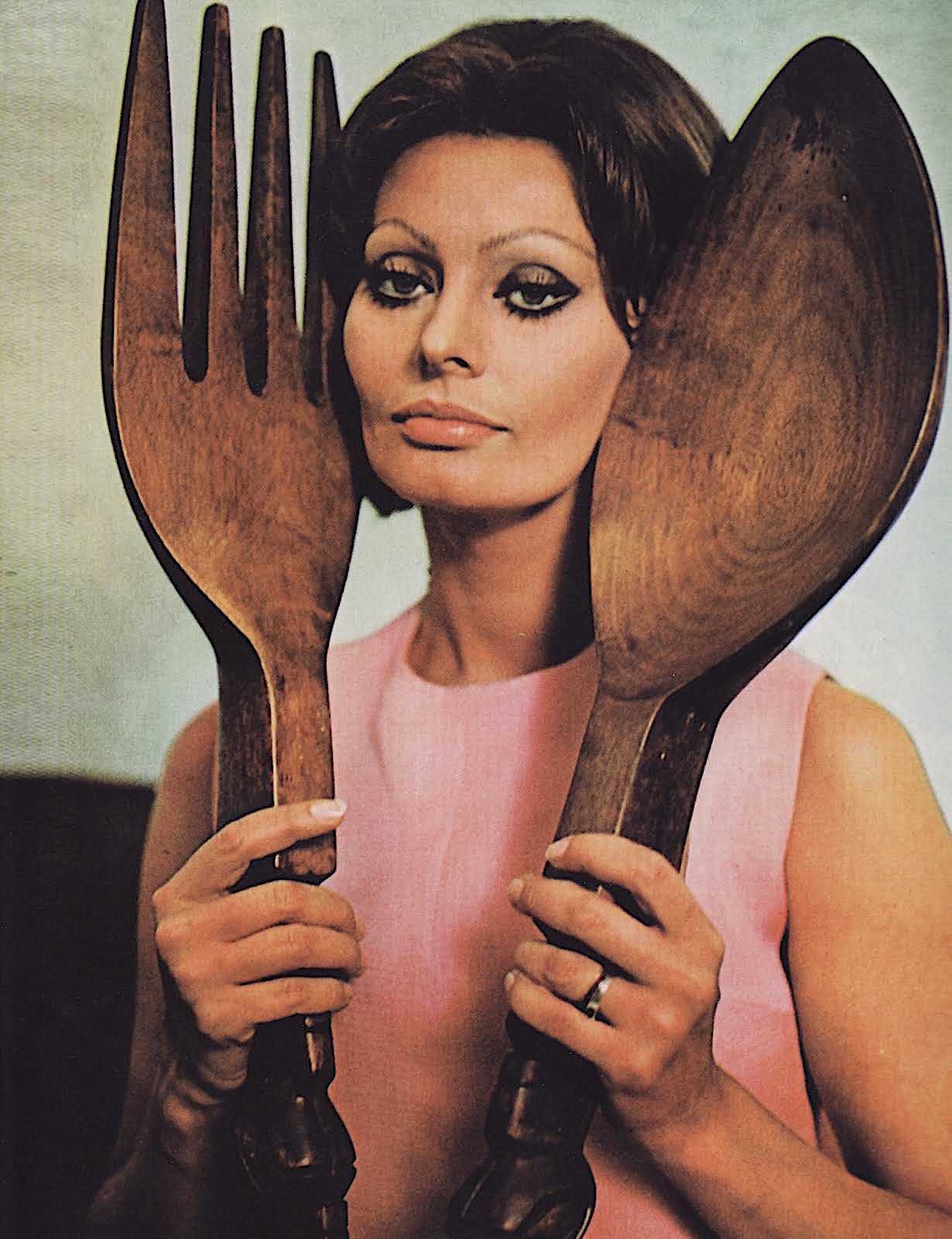
Back in the ‘90s, by the time the late Dr. Atkins had declared carbohydrates the Great Satan of weight gain, an obtuse book editor rejected my proposal for an Italian cookbook by saying, “Nobody’s eating pasta anymore!” Since then about a thousand Italian cookbooks have been published, and there seems no end in sight, for good reason. Fad diets aside, people everywhere just out and out love Italian food, and, Grazie Dio!, more and more authentic regional Italian cookbooks are coming out. Here are some new ones I like very much, most of them first published in Italy, so they have some backbone.
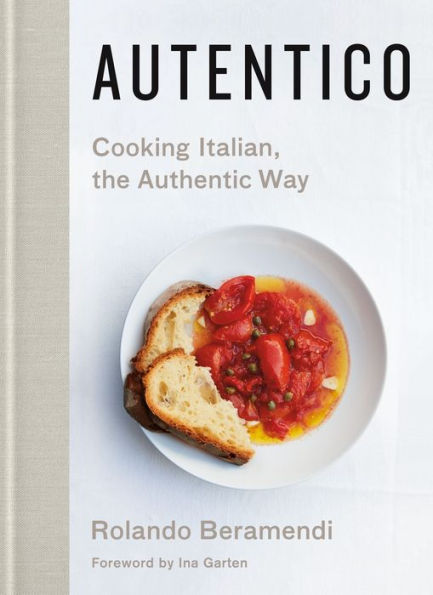
AUTENTICO:
Cooking Italian the Authentic Way by Rolando
Beramendi
(St. Martin’s Press, $35)—Despite the simpleminded
translation of the title
into a subtitle, this sturdy volume pretty much
lives up to its claim. Beramendi has a refreshing
viewpoint:
He’s founder of the Italian fine food importing
company Manicaretti, so he’s
wholly familiar with the best and the worst
products available to make
authentic Italian cuisine, both the familiar, like
cacio e pepper and farro soup, but
more unusual dishes like
canaroli rice custard wrapped in chard leaves and
Abruzzese fish stew. The instructions are clear
and concise,
the photographs excellent. 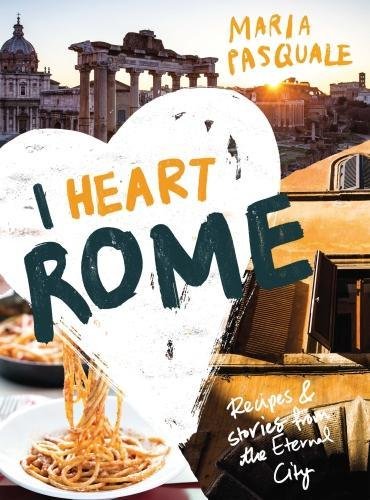
I
HEART ROME: Recipes & Stories from the
Eternal Cityby
Maria Pasquale (Smith Street Books, $35)—Another
dubious title, but Maria
Pasquale’s passion for Rome is palpable in this
finely illustrated volume that
sticks to real Roman dishes, from fried artichokes
and puntarelle to coda alla
vaccinara and cassola cheesecake. There
is good advice on Italian markets
and lively profiles of expert cooks and purveyors.
The cooking directions are
longer than they need be, which can be off-putting
for simple biscuits like brutti ma
buoni.
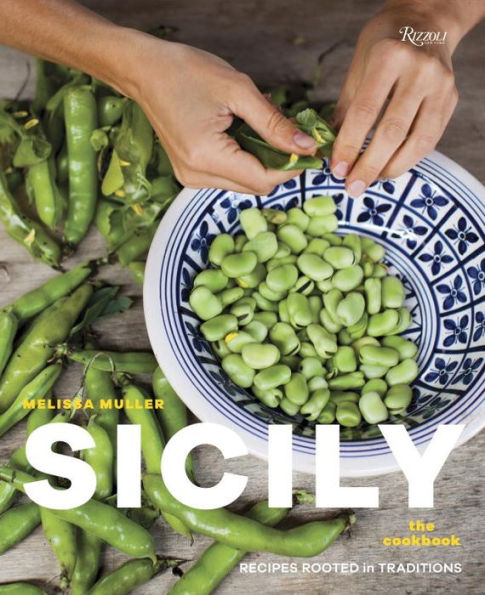
SICILY:
The Cookbook By Melissa Muller (Rizzoli, $40). Now, there’s a straightforward title, and
the book delivers.
The author has opened three Sicilian
restaurants in New York and has migrated to a farm
in Sicily to pursue her
great love for the vast, fertile island.
She wisely shows how Sicilian cuisine and
chefs have come squarely into
the 21st century without losing any of the
region’s soulfulness, so you’ll find
recipes for grilled octopus and chickpea puree,
seafood risotto with mint
pesto, grated pasta with pumpkin and ricotta, and
sweet and sour
swordfish. Typical
of Rizzoli, it’s
a beautiful work.
SICILIA:
The Cooking of Casa Planeta By Elisia
Menduni (Mondadori Electa, $35)—How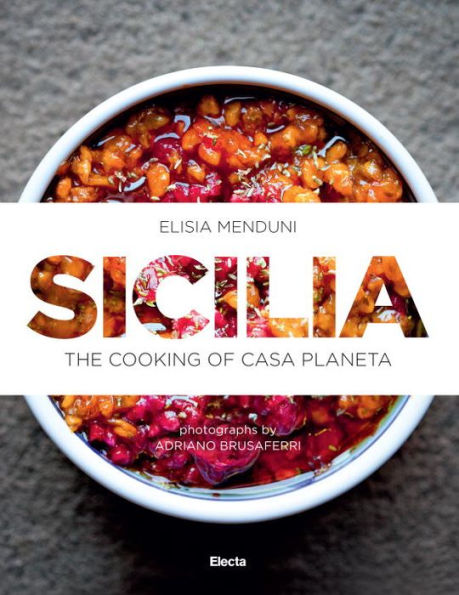 many Sicilian cookbooks do you
need? One or two or three or more.
The Planeta family has a long
heritage—their award-winning wines and
olive oils are described in the appendix—and
Italian journalist Elisia Menduni
has a deep respect and affection for the family’s
traditions, especially the
cooking of the Planeta women, evident in simple
dishes like eggplant cutlets
and chickpea fritters, stuffed peppers and stuffed
meatloaf. The
pastas, like caserecce with fava beans and
ricotta, are hearty and seasonal, and
the pastries
show the versatility
various food cultures brought to an island as
Greek and Moorish as it is
Italian.
many Sicilian cookbooks do you
need? One or two or three or more.
The Planeta family has a long
heritage—their award-winning wines and
olive oils are described in the appendix—and
Italian journalist Elisia Menduni
has a deep respect and affection for the family’s
traditions, especially the
cooking of the Planeta women, evident in simple
dishes like eggplant cutlets
and chickpea fritters, stuffed peppers and stuffed
meatloaf. The
pastas, like caserecce with fava beans and
ricotta, are hearty and seasonal, and
the pastries
show the versatility
various food cultures brought to an island as
Greek and Moorish as it is
Italian.
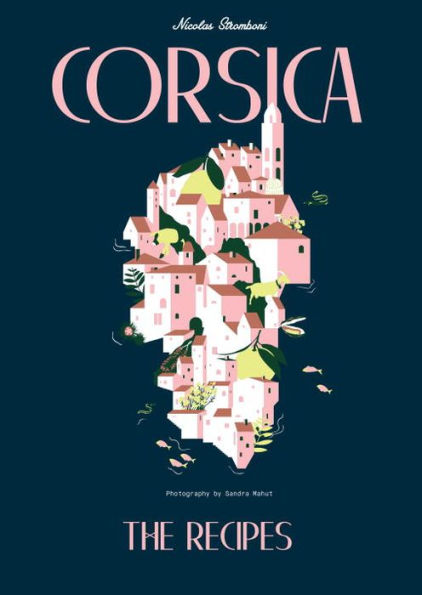
CORSICA:
The Recipes By Nicolas Stromboni
(Smith Street Books, $40)—Yes,
I know, Corsica
is a French
territory, but only because they robbed it from
the Corsicans, who themselves
freed it from centuries of Genoese rule. So, the
island is much more Italian in
its cooking than it is French, as Nicolas
Stromboni, a wine merchant based in
Ajaccio, clearly shows in a volume that begins
with charcuterie like coppa,
prisuttu and pancetta. Vegetables figure largely in
Corsican cooking, as in lentils
with figatelli
sausage, and the
cheeses of the region are highlighted.
Corsica is an island, so seafood abounds in
wondrous dishes, like fish
soups and mussels with peas and artichokes. Pastas, however, are few--cannelloni with whipped brocciu
cheese is very local. And,
once you make the very simple Corsican cheesecake
called fiadone, it will become a treasured
favorite.
 WHAT
I'M DRINKING FOR CHRISTMAS
WHAT
I'M DRINKING FOR CHRISTMASBy John Mariani
Christmas is upon us and, while my family’s menu choices have not been pinned down, I yearn at the thought of roast goose and prime rib with Yorkshire pudding at Christmas. Our family doesn’t do the “Feast of the Seven Fishes” that Italians do on Christmas Eve, but there are some fabulous Peconic bay scallops in the market these days, so I have some thoughts on what to drink with those, and other holiday fare.
VERMENTINO
CAMPO ALLE COMETE 2016 ($20)—A Tuscan white of
great charm, which is not so
much a rarity as it is a relief from 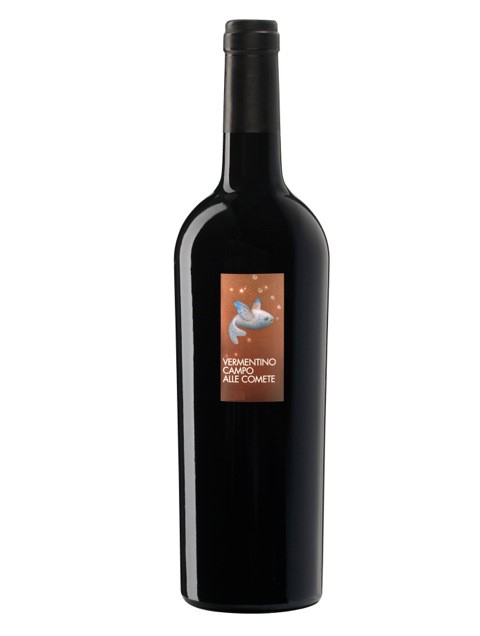 so many dull examples.
This 100%
Vermentino comes from the region around Livorno.
The name comes from an antique
toponym from this area, meaning “guiding star”
or “comet" in Italian. Its
citrusy, grapefruit-like notes and light
sweetness make it a fine match with
scallops or shellfish.
so many dull examples.
This 100%
Vermentino comes from the region around Livorno.
The name comes from an antique
toponym from this area, meaning “guiding star”
or “comet" in Italian. Its
citrusy, grapefruit-like notes and light
sweetness make it a fine match with
scallops or shellfish.
MCBRIDE SISTERS COLLECTION CENTRAL COAST CHARDONNAY 2016 ($24)—Bi-continental winemaking siblings Robin, in Monterey, California, and Andrea, in Marlborough, New Zealand—who only met when they were adults—may live thousands of miles from each other but they share the same philosophy of crafting finesse from Old World traditions. This Chardonnay has a touch of sweetness and good body, but the acid is sufficient to meld it together, so that this would go very well with oilier fishes like salmon, and, if you are so inclined on Christmas Eve, eel. I did have to laugh at Robin’s description of the wine’s bouquet as having “white flower and face-powder to round out a nose.” See what you think.
ÉMILE BÉRANGER POUILLY-FUISSÉ 2015 ($40)—It gets tiresome to explain that the reputation of the lesser Burgundies has been restored by small producers, as is the case with Emile Beranger, whose family has been involved making Pouilly-Fuissé for two hundred years. They know the terroir, so the wines they make show the characteristic flintiness of the soil. I haven’t a clue what one wine scribbler meant by calling the wine “shiny yet demure,” but it does have a lush texture not easy to find in the wines of the Maconnais.
CHÂTEAU
POUJEAUX MOULIS-EN-MÉDOC 2010 ($40)—As a blend
of 48% Cabernet  Sauvignon,
45%
Merlot and touches of Petit Verdot and Cabernet
Franc, with 14% alcohol, this
is everything a Bordeaux fan will love without
breaking the bank. The château
itself dates to the 16th century, but the
vineyards have been restored and
improved since 2008 under new owners, the
Cuvelier family, who also own the
better known Clos Fourtet in St.
Émilion. Hang times are a bit longer
and biodynamic philosophy rules. It would be
ideal with prime rib of beef for
Christmas for it’s got the body, the softened
tannins and the acid to
complement the fatted meat.
Sauvignon,
45%
Merlot and touches of Petit Verdot and Cabernet
Franc, with 14% alcohol, this
is everything a Bordeaux fan will love without
breaking the bank. The château
itself dates to the 16th century, but the
vineyards have been restored and
improved since 2008 under new owners, the
Cuvelier family, who also own the
better known Clos Fourtet in St.
Émilion. Hang times are a bit longer
and biodynamic philosophy rules. It would be
ideal with prime rib of beef for
Christmas for it’s got the body, the softened
tannins and the acid to
complement the fatted meat.
TENUTE ASINARI DEI MARCHESI DI GRESY NEBBIOLO MARTINENGA 2015 ($20)—No wine deserves a name this long, so suffice it to say that this is a very authentic expression of the Nebbiolo grape from the Barbaresco region, though not labeled as a true Barbaresco, which would be quite a bit more expensive. This has a lighter body and spends little time in oak before release at 13.5% alcohol, so it’s very versatile and easy to drink with game birds and turkey.
DOMAINE DE JAVERNIÉRE CHÂTEAU PY MORGON 2016 ($20)—A good price for a very good Beaujolais Cru made from the Gamay grape. Morgon’s vineyard area occupies only about 4.5 square miles, and the wines are usually the most robust of the ten crus. I like the spice here and the definite taste of the Gamay. Even though young, this is already a wine to enjoy with roast goose, chicken or turkey, and it’s particularly good with goat’s cheeses.
CHÂTEAU GREYSAC CRU BOURGEOIS MÉDOC 2012 ($13)—Sometimes you get more than you pay for, and this delightful Bordeaux, which sadly must go through life called “bourgeois,” is the kind of sturdy red wine, at 13% alcohol, you could drink with pleasure night after night. The blend of 65% Merlot, 32% Cabernet Sauvignon and 3% Petit Verdot provides a good deal of rich flavor, if not much depth on the finish. Drink it now.
❖❖❖
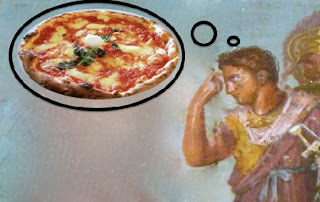
SOMEHOW WE DOUBT VIRGIL WAS
REFERRING TO PIZZA IN THE AENEID
"In the Aeneid, Virgil put forward a
prophecy founded on proto-pizza consumption, which
foretells where Rome shall be built. ‘When hunger shall
drive you, landed on unknown Shores, to eat the tables
at your frugal meal,' Aeneas recalls his father telling
him, `Remember to place your first buildings there.'
These ‘tables,' Aeneas later realizes, falling to his
knees, are plates made of hard bread off which his band
of Trojan refugees eat lunch.”--"Camillo" by Carolyn
Kormann, The New
Yorker (11/27/17)
THEY'RE THINKING OF CHANGING IT TO
"KREEMA SUM YUNG GUY"
Ryan Vermaak and Fabio Di Cosmo, two white owners apologized after
they named their fusion restaurant in Johannesburg, South Africa, “Misohawni.”
Any of John Mariani's books below may be ordered from amazon.com.
 The Hound in Heaven
(21st Century Lion Books) is a novella,
and for anyone who loves dogs, Christmas, romance,
inspiration, even the supernatural, I hope you'll find
this to be a treasured favorite. The story
concerns how, after a New England teacher, his wife and
their two daughters adopt a stray puppy found in their
barn in northern Maine, their lives seem full of promise.
But when tragedy strikes, their wonderful dog Lazarus and
the spirit of Christmas are the only things that may bring
his master back from the edge of despair.
The Hound in Heaven
(21st Century Lion Books) is a novella,
and for anyone who loves dogs, Christmas, romance,
inspiration, even the supernatural, I hope you'll find
this to be a treasured favorite. The story
concerns how, after a New England teacher, his wife and
their two daughters adopt a stray puppy found in their
barn in northern Maine, their lives seem full of promise.
But when tragedy strikes, their wonderful dog Lazarus and
the spirit of Christmas are the only things that may bring
his master back from the edge of despair. WATCH THE VIDEO!
“What a huge surprise turn this story took! I was completely stunned! I truly enjoyed this book and its message.” – Actress Ali MacGraw
“He had me at Page One. The amount of heart, human insight, soul searching, and deft literary strength that John Mariani pours into this airtight novella is vertigo-inducing. Perhaps ‘wow’ would be the best comment.” – James Dalessandro, author of Bohemian Heart and 1906.
“John Mariani’s Hound in Heaven starts with a well-painted portrayal of an American family, along with the requisite dog. A surprise event flips the action of the novel and captures us for a voyage leading to a hopeful and heart-warming message. A page turning, one sitting read, it’s the perfect antidote for the winter and promotion of holiday celebration.” – Ann Pearlman, author of The Christmas Cookie Club and A Gift for my Sister.
“John Mariani’s concise, achingly beautiful novella pulls a literary rabbit out of a hat – a mash-up of the cosmic and the intimate, the tragic and the heart-warming – a Christmas tale for all ages, and all faiths. Read it to your children, read it to yourself… but read it. Early and often. Highly recommended.” – Jay Bonansinga, New York Times bestselling author of Pinkerton’s War, The Sinking of The Eastland, and The Walking Dead: The Road To Woodbury.
“Amazing things happen when you open your heart to an animal. The Hound in Heaven delivers a powerful story of healing that is forged in the spiritual relationship between a man and his best friend. The book brings a message of hope that can enrich our images of family, love, and loss.” – Dr. Barbara Royal, author of The Royal Treatment.
 |
The Encyclopedia of American Food and Drink by John F. Mariani (Bloomsbury USA, $35) Modesty forbids me to praise my own new book, but let me proudly say that it is an extensive revision of the 4th edition that appeared more than a decade ago, before locavores, molecular cuisine, modernist cuisine, the Food Network and so much more, now included. Word origins have been completely updated, as have per capita consumption and production stats. Most important, for the first time since publication in the 1980s, the book includes more than 100 biographies of Americans who have changed the way we cook, eat and drink -- from Fannie Farmer and Julia Child to Robert Mondavi and Thomas Keller. "This book is amazing! It has entries for everything from `abalone' to `zwieback,' plus more than 500 recipes for classic American dishes and drinks."--Devra First, The Boston Globe. "Much needed in any kitchen library."--Bon Appetit. |
"Eating Italian will never be the same after reading John Mariani's entertaining and savory gastronomical history of the cuisine of Italy and how it won over appetites worldwide. . . . This book is such a tasteful narrative that it will literally make you hungry for Italian food and arouse your appetite for gastronomical history."--Don Oldenburg, USA Today. "Italian
restaurants--some good, some glitzy--far
outnumber their French rivals. Many of
these establishments are zestfully described
in How Italian Food Conquered the World, an
entertaining and fact-filled chronicle by
food-and-wine correspondent John F.
Mariani."--Aram Bakshian Jr., Wall Street
Journal.
"Equal parts
history, sociology, gastronomy, and just
plain fun, How Italian Food Conquered the
World tells the captivating and delicious
story of the (let's face it) everybody's
favorite cuisine with clarity, verve and
more than one surprise."--Colman Andrews,
editorial director of The Daily
Meal.com. "A fantastic and fascinating
read, covering everything from the influence
of Venice's spice trade to the impact of
Italian immigrants in America and the
evolution of alta cucina. This book will
serve as a terrific resource to anyone
interested in the real story of Italian
food."--Mary Ann Esposito, host of PBS-TV's
Ciao
Italia. "John Mariani has written the
definitive history of how Italians won their
way into our hearts, minds, and
stomachs. It's a story of pleasure over
pomp and taste over technique."--Danny Meyer,
owner of NYC restaurants Union Square
Cafe, The Modern, and Maialino.
|
 |
 |
 |
 |
 |
 |
 |
 |
 Everett Potter's Travel Report:
Everett Potter's Travel Report: 
 Eating Las Vegas
JOHN CURTAS has been covering the Las Vegas
food and restaurant scene since 1995. He is
the co-author of EATING LAS VEGAS – The 50
Essential Restaurants (as well as
the author of the Eating Las Vegas web site: www.eatinglasvegas.
He can also be seen every Friday morning as
the “resident foodie” for Wake Up With the
Wagners on KSNV TV (NBC) Channel 3 in
Las Vegas.
Eating Las Vegas
JOHN CURTAS has been covering the Las Vegas
food and restaurant scene since 1995. He is
the co-author of EATING LAS VEGAS – The 50
Essential Restaurants (as well as
the author of the Eating Las Vegas web site: www.eatinglasvegas.
He can also be seen every Friday morning as
the “resident foodie” for Wake Up With the
Wagners on KSNV TV (NBC) Channel 3 in
Las Vegas.

MARIANI'S VIRTUAL GOURMET
NEWSLETTER is published weekly. Editor/Publisher: John
Mariani.
Editor: Walter Bagley. Contributing Writers: Christopher Mariani,
Robert Mariani, Misha Mariani, John A. Curtas, Geoff Kalish, Mort
Hochstein, and
Brian Freedman. Contributing Photographer: Galina
Dargery. Technical Advisor: Gerry McLoughlin.
To un-subscribe from this newsletter,click here.
© copyright John Mariani 2017

